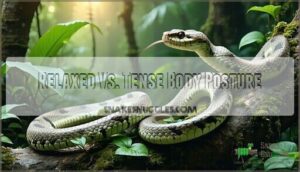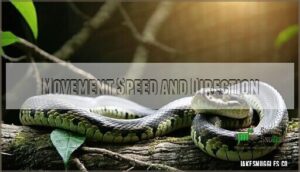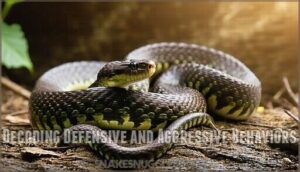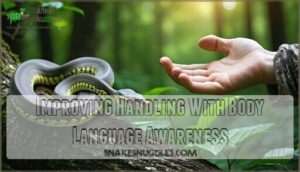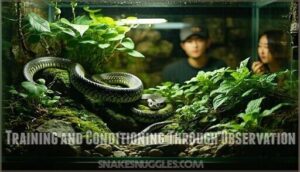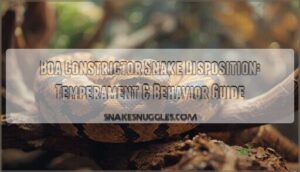This site is supported by our readers. We may earn a commission, at no cost to you, if you purchase through links.
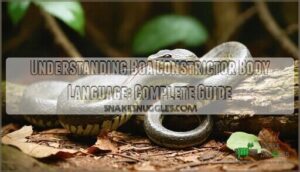
Learning to interpret relaxed versus tense postures, decode movement patterns, and recognize stress before it escalates transforms your relationship with your snake. You’ll handle with confidence, reduce unnecessary stress for both of you, and spot potential health issues before they become serious problems.
The difference between a handler who reacts to strikes and one who prevents them entirely comes down to fluency in your boa’s silent language.
Table Of Contents
- Key Takeaways
- Key Boa Constrictor Body Language Signals
- Recognizing Signs of Stress and Discomfort
- Decoding Defensive and Aggressive Behaviors
- Understanding Social and Reproductive Signals
- Improving Handling With Body Language Awareness
- Training and Conditioning Through Observation
- Frequently Asked Questions (FAQs)
- Conclusion
Key Takeaways
- Your boa’s body language—loose coils, steady tongue flicking, and smooth movements—tells you whether it’s relaxed or stressed long before defensive behaviors like hissing or striking appear.
- Subadult boas between 1.5 and 3 years show the most intense defensive reactions, with stress hormones surging up to fifteen times normal levels, while juveniles and adults display milder, more predictable responses.
- Males follow female pheromone trails for up to seven days with tongue-flick rates reaching 68 flicks per minute, and they converge in reproductive aggregations with ratios sometimes reaching five males to one female.
- Gradual handling that respects your snake’s signals—starting with five-minute sessions after a week-long acclimation period and using tools like snake hooks when needed—builds trust and prevents stress-related aggression.
Key Boa Constrictor Body Language Signals
Reading your boa’s body language starts with understanding the basics—how a relaxed snake moves versus one that’s stressed or defensive.
Here’s what those key signals actually mean.
Relaxed Vs. Tense Body Posture
When you watch a boa constrictor move through its enclosure, the difference between a relaxed snake and a tense one often shows up in the body itself—loose and flowing versus rigid and coiled tight.
A calm boa displays distinct relaxation signs:
- Loose coils that drape naturally without muscle tension
- Smooth, unhurried movements across branches or substrate
- Even body alignment from head to tail
- No defensive posture like inflation or tight bunching
When you spot these stress signals, you’ll know it’s time to rethink your handling approach and give your snake the space it needs to settle down.
Tongue Flicking and Head Movement Cues
Your boa’s tongue—flicking steadily in and out—is gathering information about its world, and the way it moves its head while doing so tells you whether it’s curious, cautious, or concerned. Consistent tongue flick rates paired with slow, sweeping head movements signal active snake exploration and healthy sensory processing of environmental cues. When your boa suddenly jerks its head back or flicks rapidly without forward movement, you’re witnessing reptile behavior that suggests wariness—part of the broader snake body language system governing animal communication and reptile communication and body language in boa constrictors.
| Head Movement | Tongue Flick Rate | What It Means |
|---|---|---|
| Smooth, slow side-to-side | Steady, rhythmic | Relaxed exploration |
| Quick jerks backward | Rapid, irregular | Startled or defensive |
| Raised, scanning upward | Moderate, consistent | Curiosity about surroundings |
| Low, minimal motion | Slow or paused | Resting or low-stress state |
| Head bobbing with approach | Fast, repeated | Evaluating potential threat |
Breathing Patterns and Their Meanings
A shift in breathing rhythm—from steady, barely noticeable breaths to rapid, shallow gulps—can reveal whether your boa feels safe or threatened before any other signal appears. Watch the sides of your snake’s body for scale vibrations and air sac movement: slow respiratory rates with deep breathing depth indicate calm, while quick, shallow breaths suggest stress.
Tracking these breathing patterns gives you insight into your snake’s body language and improves your reptile training approach.
Temperature changes naturally affect how your snake breathes during everyday interactions.
Movement Speed and Direction
Once you track how breathing shifts under stress, the way your boa actually moves—its speed and the path it takes—gives you another layer of insight into what it’s thinking and feeling.
A relaxed body language shows steady, flowing motion with few direction changes, while stressed snakes display jerky speed variations and erratic body alignment:
- Slow, deliberate movement signals comfort and curiosity during exploration
- Sudden freezes often precede defensive strikes or heightened alertness
- Rapid, chaotic motion cues indicate fear or an urgent escape response
- Smooth direction changes reflect calm reptile communication and body language
- Rigid body alignment warns of imminent defensive behavior
Learning to read these movement patterns makes you better at training your boa and spotting stress signals before things get tense.
Recognizing Signs of Stress and Discomfort
Stress in boa constrictors isn’t always obvious—some signals are loud, while others are easy to miss.
Here’s what to watch for so you can recognize when your snake needs space or a change in approach.
Defensive Body Inflation and Posturing
When a boa constrictor feels cornered or threatened, it doesn’t just sit there—it transforms itself into what looks like a much bigger, more intimidating version of its normally sleek self. This defensive inflation involves drawing air deep into the lungs, expanding the body diameter noticeably. You’ll see the snake flatten and broaden, especially around the neck and mid-body regions. It’s a clear stress signal that says, "Back off."
| Inflation Signal | What You’re Seeing |
|---|---|
| Expanded girth | Body diameter increases 20–40% |
| Flattened profile | Dorsoventral compression visible |
| Rigid musculature | Tense, non-flowing movement |
| Elevated positioning | Head raised, S-curved neck |
Compare that to a relaxed boa—loose, flowing, almost liquid in how it moves.
Hissing, Striking, and Freezing Behaviors
If your boa constrictor suddenly pulls back, opens its mouth, and releases a sharp hiss, you’re watching escalation unfold—these aren’t isolated quirks but coordinated warnings that demand your immediate attention.
Hissing sounds serve as auditory threat displays, often paired with an open-mouthed strike posture. Freezing postures can precede explosive defensive mechanisms.
Understanding snake behavior means recognizing these stress signals early—strike prevention depends on respecting your snake’s body language, not pushing past clear boundaries.
Immobility Versus True Relaxation
Stillness in your boa doesn’t always signal comfort—sometimes it’s a mask hiding elevated stress beneath a frozen exterior. True relaxation shows a loose, draped body with gentle tongue flicking, while immobility cues often include rigid muscles and shallow breathing patterns.
Don’t mistake freezing for calmness—physiological stress signals can persist even when your snake appears motionless, demanding careful observation of subtle body language shifts.
Age-related Differences in Stress Responses
Your boa’s age significantly influences how stress manifests. Subadults, in particular, exhibit peak defensiveness during their second and third years, displaying far more intense reactions compared to juveniles or adults. Stress hormones can surge up to fifteen times the normal level during contact, with physiological responses varying dramatically across maturation patterns.
Younger boas show less intense defensive reactions, while fully grown snakes develop stress patterns that seasoned keepers learn to read reliably.
Recognizing how these behaviors shift with age helps you adapt your handling approach to match where your snake is in its development. This means you can time and adjust your interactions based on what stage your boa has reached.
By following proper boa constrictor care, you can minimize stress and foster a healthy environment for your pet.
Decoding Defensive and Aggressive Behaviors
When your boa constrictor shifts from calm to defensive, you’ll want to recognize the signs before things escalate.
Understanding what triggers these behaviors—and how age affects their intensity—helps you handle your snake safely and avoid unnecessary stress for both of you.
Early Warning Signs Before Striking
Before a boa constrictor strikes, you’ll notice its body coil tightly into an S-shape, with the neck pulled back like a compressed spring ready to release.
Watch for the head to fixate on you without wavering—that locked stare signals the boa constrictor is calculating distance. Rapid tongue flicking often stops abruptly, and the body may tremble slightly as muscles tense for the strike.
These pre-strike behaviors give you seconds to retreat and avoid triggering an attack.
Differences Between Juvenile, Subadult, and Adult Responses
You’ll notice striking differences in how boa constrictors respond across developmental stages. Juveniles rely on tongue flicking and freezing rather than aggressive strikes, showing a defensive behavior correlation of just r = 0.44. Subadults between 1.5–3 years hit peak aggression (r = 0.7), escalating quickly to hissing and striking as they shift toward sexual maturity.
Adult boas show selective yet powerful defensive reactions. When stressed, their breathing quickens while their heart rate actually slows—a counterintuitive pattern that reflects behavioral maturity and more calculated defense tactics honed through years of experience.
The ability to detect chemical age cues plays a key part in deciphering these developmental stages and social interactions.
Environmental Triggers for Defensive Behavior
Your snake’s surroundings shape its defensive reactions more than you might expect, with sudden temperature drops, vibrations, and confined spaces triggering rapid escalations from calm to strike-ready.
Temperature fluctuations and humidity levels disrupt your boa constrictor’s thermoregulation, while lighting changes and noise pollution heighten stress responses.
Spatial constraints during reptile manipulation cut off escape routes, ramping up defensive postures—when you recognize these environmental triggers, you’ll spot behavioral shifts faster and refine how you handle your snake.
Understanding Social and Reproductive Signals
Boa constrictors don’t just communicate through defensive signals—they also use distinct body language during mating season and social encounters.
Picking up on these reproductive and social cues lets you tell when your snake is reacting to seasonal shifts or engaging with potential mates in a breeding environment.
Courtship Body Language and Male-female Interactions
When a male boa constrictor finds a receptive female, he doesn’t just approach—he performs an intricate, tactile dance that reveals courtship in motion. You’ll notice several distinct mating rituals and courtship signals:
- Male alignment with the female’s body, often positioning himself parallel
- Gentle rubbing using his pelvic spurs in posterior-to-anterior strokes
- Female receptivity shown through a fully stretched, passive posture
- Males displaying heightened chemosensory tongue flicking to confirm readiness
- Reproductive aggregations forming with multiple males surrounding one female
Spotting these courtship patterns lets you tell when your boa constrictor is engaging in natural reproductive behavior.
Pheromone Trails and Chemosensory Responses
Pheromone detection is a key driver of reproductive communication in boa constrictors. Males exhibit rapid tongue-flicking behavior, with rates of up to 68 flicks per minute near conspecific scent trails, compared to only 13–21 flicks per minute on neutral surfaces. This behavior highlights the importance of chemical signaling in their communication.
| Trail Age | Male Response Rate | Tongue-Flick Frequency |
|---|---|---|
| 0–7 days | 100% tracking | 40–68 flicks/min |
| 14 days | 71% tracking | Reduced by ~29% |
| Blank control | Minimal interest | 13–21 flicks/min |
Males reliably follow female scent trails for up to seven days, with their responses declining by 29% after two weeks as the chemical signals degrade. Additionally, age plays a significant role in scent recognition, with adult scents triggering responses 42% stronger than juvenile ones. This chemosensory mechanism, processed through the vomeronasal organ, helps males locate receptive females and maintain social structure.
Learning to read these scent patterns gives us practical insight into snake behavior and helps fine-tune breeding season management strategies.
Reproductive Aggregations and Group Dynamics
Once males pick up the scent, they don’t just wander off—they converge, sometimes in surprising numbers, around a single receptive female. Wild observations document ratios reaching 1:5, with multiple males competing for access during the austral autumn and winter.
This aggregation pattern reflects both social hierarchy and group synchronization tied to reproductive cycles. Understanding these mating rituals and body language helps you recognize natural boa constrictor behavior, improving your reptile management and herpetology practices during breeding season.
Improving Handling With Body Language Awareness
When you understand your boa’s body language, handling sessions get easier—and safer—for everyone involved. Let’s look at some practical ways to use what you’ve learned.
Safe Initial Handling and Acclimation Periods
The first week after bringing home a boa constrictor isn’t just a settling-in period—it’s a critical window that shapes how your snake reacts to you for months or even years to come. During these initial acclimation techniques, resist the urge to touch your new boa. Instead, watch its body language closely—if it’s hiding constantly or displaying defensive postures, it needs more time.
Safe initial touching tips include:
- Wait at least seven days before any gentle interaction attempts
- Watch for relaxed body language: loose coils, steady tongue flicking, calm breathing patterns
- Delay touching entirely if your boa refuses food or stays tucked away
- Start with just five minutes once stress reduction methods show the snake’s comfortable
Getting these basics right early on makes everything easier down the road—your boa learns to tolerate handling without building up stress that snowballs into defensive behavior later.
Gradual Session Lengthening for Taming
After those first cautious five-minute sessions, extending your interaction time becomes less about the clock and more about reading what your boa is actually telling you. Watch for loose coils and steady tongue flicking—signs your snake acclimation is progressing well.
Gradually add a few minutes each week, using body language as your guide for trust building and effective taming techniques in boa constrictor care and interaction.
Using Snake Hooks and Tools for Stress Reduction
A snake hook won’t eliminate stress entirely, but it can help you back off from direct hand contact when your boa’s body language says "not yet ready." Hook training allows gentle restraint while you observe stress recognition cues like rigid posture or rapid breathing.
- Slide the hook under mid-body, never behind the head
- Watch for loose coiling around the hook—a trust signal
- Use hooks during cage cleaning to redirect without hand threat
- Pair tool usage with body language observation for stress reduction
- Shift to hands gradually as defensive postures fade
This approach respects your boa’s communication and builds confidence through patient, low-pressure snake usage.
Hygiene Practices for Handler and Snake Safety
Keeping both you and your boa healthy starts with washing your hands—before and after every management session—because cross-contamination works both ways.
Use soap and water for proper reptile management, not just sanitizer, since residues can irritate your snake’s skin.
Clean environments reduce bacterial transfer during animal management, so disinfect surfaces regularly and wear fresh clothes for each boa constrictor care and management session to assist both snake hygiene and handler precautions in herpetology and reptile care.
Training and Conditioning Through Observation
Once you understand how your boa perceives and interacts with the world around it, you can use that knowledge to shape behavior through careful observation and positive reinforcement.
What follows breaks down exactly how to read your boa’s body language and use it to create a snake that’s both relaxed and responsive.
Leveraging Body Language for Operant Conditioning
Reading your boa’s body language isn’t just helpful for training—it’s the foundation that makes operant conditioning actually work. When you recognize a relaxed posture—loose coils, steady tongue flicks—you’ll know it’s the right moment to introduce reward systems or environmental enrichment.
Catch stress signals early and you can adjust before your boa gets defensive. Behavioral analysis makes each session count—you’re building trust through observation, not trial and error.
Building Trust and Reducing Stress During Training
Trust doesn’t happen overnight—it’s built through repeated, predictable interactions where your boa learns you’re not a threat. Gentle management during short sessions helps with stress reduction, especially when you keep movements slow and avoid sudden changes.
Calming environments foster trust building—think dim lighting and minimal noise during training techniques that rely on operant conditioning principles.
Catching stress signals early shows you’ve got solid reptile management skills—and that’s what turns routine boa care into successful conditioning.
Monitoring Health and Well-being via Behavioral Cues
Your snake’s behavioral patterns reveal critical health indicators before obvious symptoms appear. Watch for decreased tongue-flicking frequency, sudden weight drops exceeding 10% biweekly, or wheezing—these physiological responses signal illness in up to 47%, 100%, and 21% of clinical cases respectively.
Environmental factors like improper humidity directly influence stress metrics, making daily observation essential for effective boa constrictor care and management.
Frequently Asked Questions (FAQs)
How often should you handle adult boas?
Generally, you’ll want to manage your adult boa two to three times weekly.
Regular, gentle interaction helps maintain socialization and prevents regression in tame individuals.
Keep sessions moderate—around 10 to 20 minutes—respecting your snake’s body language throughout each management session.
Can boas recognize their handlers scent?
Do boas recognize their handler’s scent? Yes, your boa uses olfactory memory and pheromone response to identify you through snake olfaction.
With consistent reptile management and animal conditioning techniques, handler identification becomes part of routine boa constrictor care and management during reptile training and management sessions.
What lighting conditions reduce boa stress levels?
Low-to-moderate light intensity with natural photoperiod control helps reduce boa constrictor stress levels.
UVB effects aren’t well-studied for nocturnal species, but consistent ambient illumination matching seasonal cycles facilitates natural behavior patterns and proper reptile care during management and conditioning techniques.
Do boas display territorial behavior in captivity?
You won’t see classic territorial marking in captivity—boas lack the scent glands for it—but they do show spatial awareness.
In well-designed enclosures, your boa may prefer specific zones for thermoregulation and security, which influences reptile management strategies and overall boa constrictor care.
How does shedding affect boa temperament?
During the shedding cycle, you’ll notice your boa becomes more defensive and reclusive—it’s uncomfortable, not aggressive. Stress recognition and management skills improve when you understand this temperament shift.
Cloudy eyes and skin issues signal vulnerability, triggering defensive behavior.
Post-shed behavior normalizes quickly, making reptile interaction safer once complete.
Conclusion
Reading your boa is like learning a new language—one whispered through muscle tension and measured breath rather than words.
Reading your boa’s body language is like learning a silent vocabulary whispered through tension and breath instead of words
Mastering understanding boa constrictor body language transforms you from a nervous handler into a confident interpreter who recognizes stress signals before they escalate, manages with precision, and builds genuine trust with your snake.
You’ll prevent defensive strikes, reduce stress for both of you, and catch health issues early by staying fluent in your boa’s silent vocabulary.
- https://pmc.ncbi.nlm.nih.gov/articles/PMC5443515/
- https://study.com/academy/lesson/boa-constrictor-size-weight-behavior-types-of-boa-snakes.html
- https://www.youtube.com/watch?v=eASaJbIYx2s
- http://www.scielo.sa.cr/scielo.php?script=sci_arttext&pid=S0034-77442012000400017
- http://reptileintelligence.blogspot.com/2018/03/understanding-snake-body-language.html

